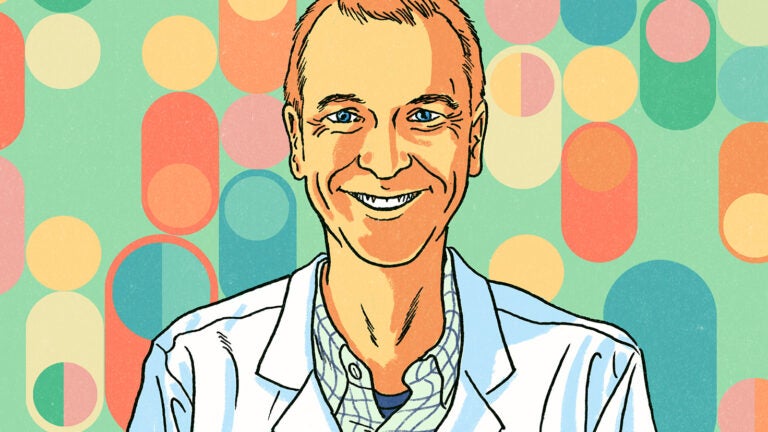
In 2014, Peter Kuhn joined USC to become a founding member of the Michelson Center for Convergent Bioscience, a 190,000-square-foot interdisciplinary research facility wholly committed to exploring new frontiers in medicine and health. (Illustration/Curt Merlo)
Finding a Cure
USC researcher Peter Kuhn possesses an unrelenting mission to improve the lives of cancer patients.
Peter Kuhn is an unlikely force in the battle against cancer.
A physicist who dreamed of designing cars at Porsche, the German native came to the United States not for academic enrichment, but for a dream inspired by the 1986 film Top Gun.
“I saw that movie and knew I needed to ride motorcycles in Southern California,” he says.
But when Kuhn was 17, his mother was diagnosed with breast cancer.
“It hits you hard and it sits there because you don’t think there’s anything you can do about it,” he says of his mother’s diagnosis.
That life-shaking event triggered his curiosity about the role physics — Kuhn’s chosen field of study — plays in the human body, such as the evolution and ecology of cancer cells.
After training at Julius-Maximilians-Universität in Würzburg, Germany, Kuhn moved to the U.S. to pursue his graduate studies in physics. Initially intending to study at UCLA and live out his Southern California fantasies, he was rerouted to upstate New York because of the 1992 Los Angeles riots.
A chance encounter then helped steer his course.
While pursuing his PhD at the University of Albany, Kuhn attended a talk by HIV/AIDS researcher Paula Fitzgerald and spoke to her afterward. Years prior, Fitzgerald and a groundbreaking team of colleagues had determined the complete three-dimensional structure of an enzyme of the AIDS virus. The team’s pioneering work ignited new therapeutic possibilities against the deadly disease.
“It was my first conversation with someone who had changed the world,” Kuhn says. “I began to wonder, ‘What if I could do something about cancer?’”
New Frontiers in Medicine and Health
Following his PhD studies at Albany, Kuhn joined the faculty at Stanford University, before the Scripps Research Institute in La Jolla wooed him to establish a physics oncology program in 2002. At Scripps, Kuhn led a team of more than 40 scientists from engineering, medicine and basic science fields working to understand the spread of cancer in the human body.
It was Kuhn’s first foray into cancer research, and it captivated him.
USC is the only place that allowed me to focus my science on improving patient outcomes, to work with as many colleagues as necessary across all the disciplines of the University for the sole purpose of making progress towards a better tomorrow.
Peter Kuhn
Kuhn remembers the first time he found cancer in a patient’s bloodstream. Fascinated, he showed the report to a collaborating pathologist. While she shared Kuhn’s scientific enthusiasm, she also offered a clinically grounded reply: “It looks like a shiny red object.” The startling disconnect of those two notions — the energetic scientific discovery and the harsh clinical reality — stunned Kuhn at first, but eventually underscored the critical importance of close collaboration between research science and clinical medicine.
“She ‘believed’ me, but made it clear I needed to do a lot more work to prove this finding in a clinically meaningful way,” Kuhn says. “As a scientist, one sometimes only sees the science, not the science existing inside a human being and that individual patient’s needs.”
In 2014, Kuhn left Scripps to become a founding member of USC’s new Michelson Center for Convergent Bioscience, a 190,000-square-foot interdisciplinary research facility wholly committed to exploring new frontiers in medicine and health.
“USC is the only place that allowed me to focus my science on improving patient outcomes, to work with as many colleagues as necessary across all the disciplines of the University for the sole purpose of making progress towards a better tomorrow,” Kuhn says. “If you want to use science to beat cancer, then this is what it takes: being able to pull expertise and resources across the entire University with agility and flexibility to discover new science and bring it to the patients in a meaningful way.”
Donors think so, too. Kuhn’s CSI-Cancer lab was made possible by a gift from Carol Vassiliadis, a cancer survivor who lost her husband to colon cancer in 2002.
Purpose-Driven, Patient-Centered Work
During the last eight years, Kuhn has established himself as one of the globe’s foremost experts on personalized medicine and individualized cancer patient care.
He co-directed the creation of the first global liquid biopsy database on cancer and helped develop groundbreaking, tech-fueled efforts injecting objectivity and measurable data into physicians’ performance status assessments. His work has advanced understanding of cancer’s movement through the body and unlocked new possibilities for expanded access to care and personalized care strategies both informed by sound biology and actionable in the clinical setting.
And to be certain, it is work rooted in purpose. While publications, presentations and patents are worthy endeavors in this ferocious battle against cancer, Kuhn maintains an unrelenting focus on improving the lives of patients.
“If not that, then what are we doing here?” he asks.
Early on in his cancer research, Kuhn recalls sitting with three women. Each had breast cancer; each held a liquid biopsy report; each asked Kuhn what they should do. Kuhn balked at their requests.
“When I started in physics, I didn’t sign up for the real world of the patient, but that day became the ultimate commitment to seeing this work to the finish line,” he says. “I wanted to figure out ways to give people thoughtful direction.”
Kuhn maintains this focus at the USC Michelson Center through events like A Night at the Lab, where students, staff and faculty engage with cancer patients. The events allow patients to share their stories with researchers while enabling researchers to clearly articulate their science to individuals yearning for answers.
“This reminds us that we’re here to help real people live longer and better lives,” he says. “This is what we focus all of our efforts around.”



